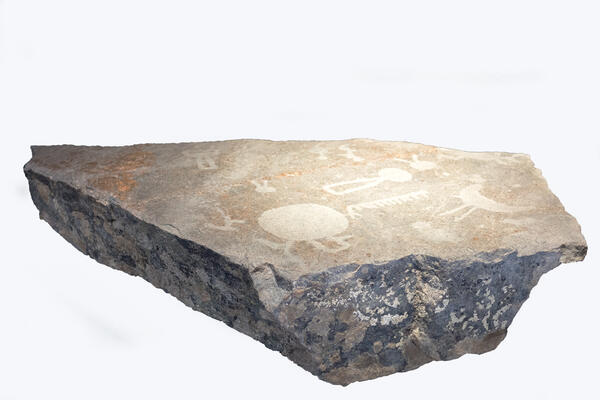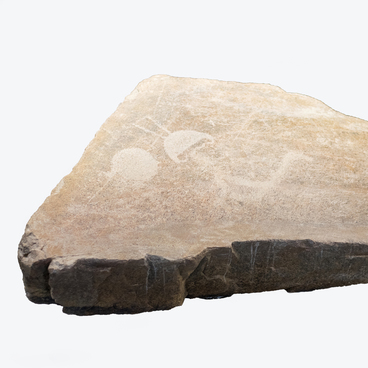Petroglyphs are carved or engraved images on a stone base. Petroglyphs include all images created since ancient times, from the Paleolithic to the Middle Ages, except those with elements of writing.
The stone slab, which is part of the exhibition, was found in 2008 by a group of archaeologists, led by Alexander Zhulnikov. The exhibit was at a height of about 2.5 meters above the modern level of Lake Onega. The researchers claim that it was part of a petroglyphic composition at the tip of the cape. The slab was found under the roots of a fallen pine.
There are 19 silhouette figures depicted on the stone, 15 of them are intact, two are slightly damaged, and only fragments of the other two are preserved. Among the figures can be seen three humans, 12 abstract images, solar signs with round elements, and one image of a boat. The other silhouettes have not yet been deciphered.
During the examination of Peri Nos VI Cape, the scientists found five more stone slabs with petroglyphs. It was found that they had been torn from the rock by strong waves and ice, and the spring ice drift had moved them to the rocky shore at a distance of about 15 meters from the previous place. The chipped fragments were thought to be lost, but thanks to the new finds, it is now possible to reconstruct the whole image of the cape.
The Onega petroglyphs slab is represented in the permanent exhibition “Stone Chronicle. The Archaeology of Karelia”. Also at the exhibition, you can see the materials of archeological research: equipment of the most ancient camp on the territory of Karelia, tools from stone working shops, reconstructed vessels of New Stone Age, various cult items and amulets from burials of famous Oleneostrovsky burial ground.
The burial site on the South Olene Island of Lake Onega dates back to the 6th millennium BC. This is the largest Mesolithic burial monument in Europe. For the first time it was investigated in 1936–1938. During the excavations, archaeologists found 177 burials with preserved bone remains, original tools for hunting and fishing, jewelry and religious objects made of stone, bone and horn, a total of more than 7 thousand objects.
The stone slab, which is part of the exhibition, was found in 2008 by a group of archaeologists, led by Alexander Zhulnikov. The exhibit was at a height of about 2.5 meters above the modern level of Lake Onega. The researchers claim that it was part of a petroglyphic composition at the tip of the cape. The slab was found under the roots of a fallen pine.
There are 19 silhouette figures depicted on the stone, 15 of them are intact, two are slightly damaged, and only fragments of the other two are preserved. Among the figures can be seen three humans, 12 abstract images, solar signs with round elements, and one image of a boat. The other silhouettes have not yet been deciphered.
During the examination of Peri Nos VI Cape, the scientists found five more stone slabs with petroglyphs. It was found that they had been torn from the rock by strong waves and ice, and the spring ice drift had moved them to the rocky shore at a distance of about 15 meters from the previous place. The chipped fragments were thought to be lost, but thanks to the new finds, it is now possible to reconstruct the whole image of the cape.
The Onega petroglyphs slab is represented in the permanent exhibition “Stone Chronicle. The Archaeology of Karelia”. Also at the exhibition, you can see the materials of archeological research: equipment of the most ancient camp on the territory of Karelia, tools from stone working shops, reconstructed vessels of New Stone Age, various cult items and amulets from burials of famous Oleneostrovsky burial ground.
The burial site on the South Olene Island of Lake Onega dates back to the 6th millennium BC. This is the largest Mesolithic burial monument in Europe. For the first time it was investigated in 1936–1938. During the excavations, archaeologists found 177 burials with preserved bone remains, original tools for hunting and fishing, jewelry and religious objects made of stone, bone and horn, a total of more than 7 thousand objects.



